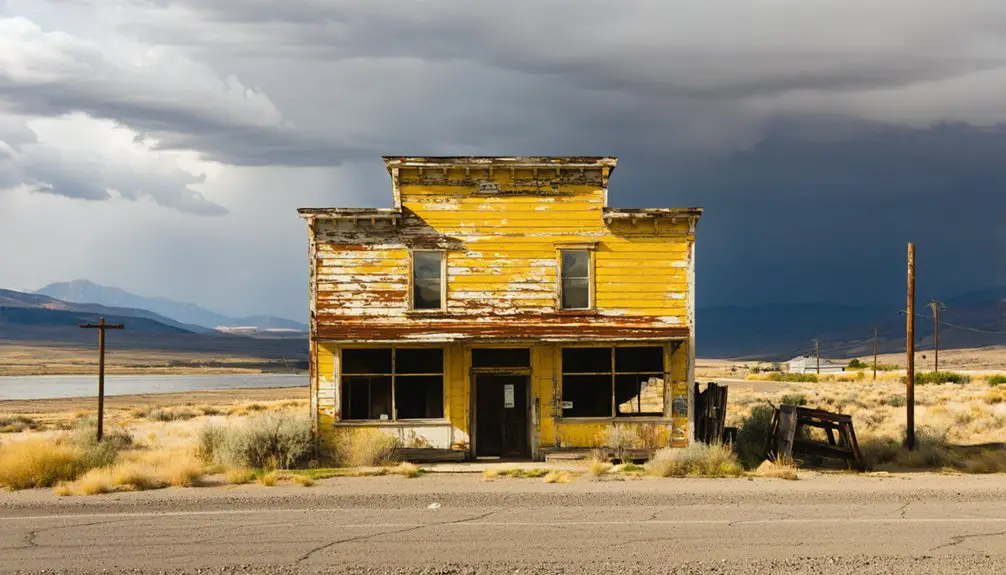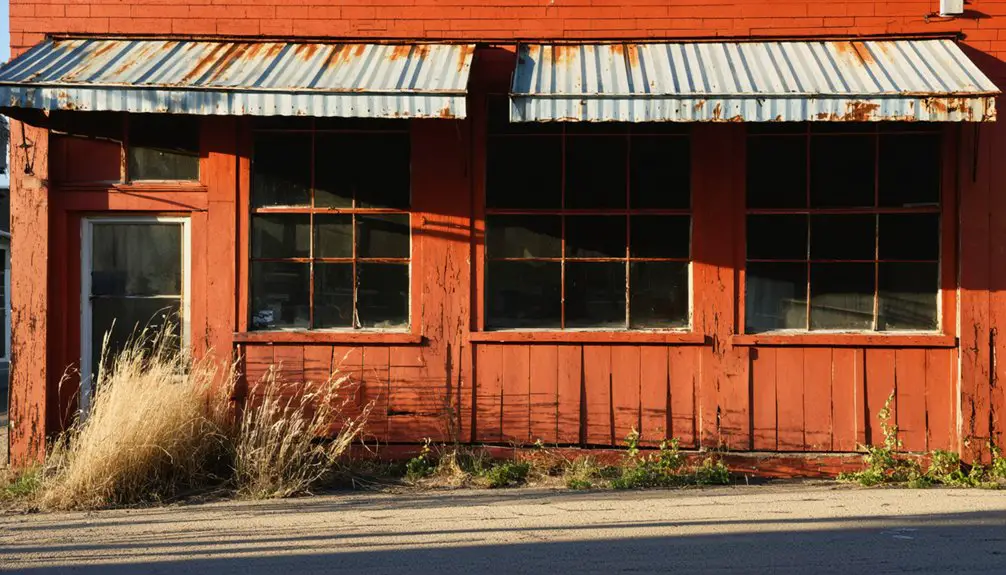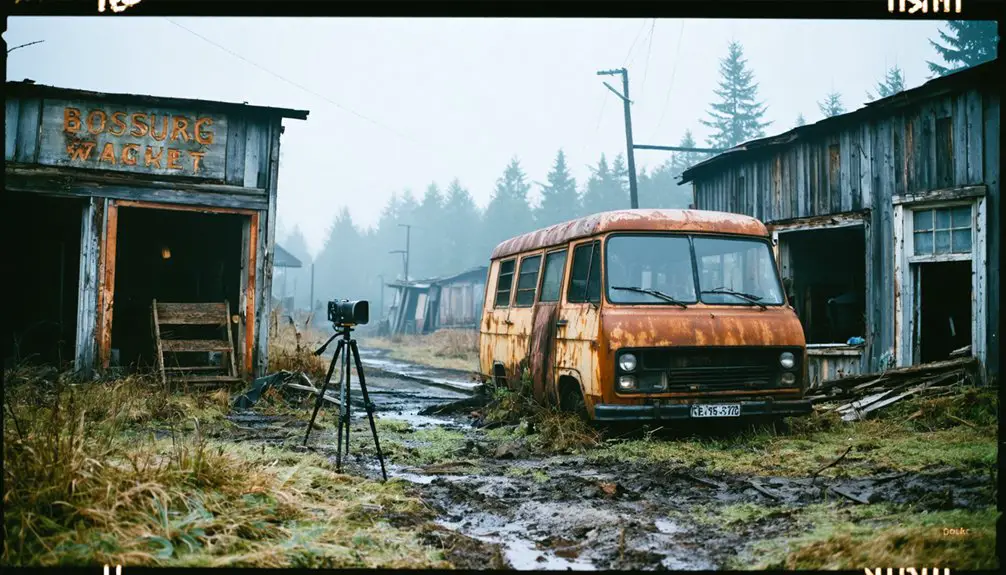You’ll find Bossburg along the Columbia River in Stevens County, Washington, where it emerged as a silver and lead mining boomtown in 1888. Originally named Young America, then Millington, it finally became Bossburg in 1897 and reached 800 residents at its peak. The town’s mines produced 940,000 pounds of lead and 70,000 ounces of silver before declining, but it gained renewed fame in 1969 when mysterious “Cripplefoot” Sasquatch tracks appeared near the town dump, leaving behind fascinating layers of history to explore.
Key Takeaways
- Bossburg was established in 1897 as a mining town, reaching 800 residents during its peak before declining due to depleted mineral resources.
- The Young America Mine produced 940,000 pounds of lead and 70,000 ounces of silver between 1905-1954 before closing operations.
- Located along the Columbia River in Stevens County, Bossburg’s ruins and cemetery remain as physical remnants of its mining past.
- The town experienced multiple name changes, from Young America to Millington, before finally becoming Bossburg through community leadership.
- Bossburg gained later notoriety for the 1969 “Cripplefoot” Sasquatch tracks, attracting researchers and maintaining cultural significance despite abandonment.
The Rise of Young America Mining Town
When prospectors discovered the Young America mine in 1885, they established one of the first major lead, zinc, and silver operations in Stevens County‘s Colville-Northport region of Washington.
You’ll find that mining activity was intermittent at first, with various companies taking charge throughout different decades. The settlement that would later become Bossburg grew around the mine as workers and their families built a thriving community. Like many mining towns, workers could join fraternal lodges for support and protection. Similar to Barkerville’s situation in British Columbia, the town experienced a rapid population boom as miners sought their fortunes.
The mine’s development sparked the creation of essential mining infrastructure, from ore processing facilities to worker housing. Though records are limited, you’d have found social and recreational activities that promoted community cohesion among the miners and their families.
Mining communities grew beyond mere infrastructure, fostering social bonds through shared activities that united workers and their families.
Between 1905 and 1954, the mine produced impressive quantities of ore: 940,000 pounds of lead, 771,000 pounds of zinc, and 70,000 ounces of silver.
From Young America to Bossburg: A Name’s Evolution
The evolution of the town’s name mirrors its early development and shifting influences. You’ll find the name significance deeply rooted in the Young America silver mine, which gave the settlement its first identity in 1888.
When the Consolidated Bonanza Mining & Smelting Company platted the town in 1893, they renamed it Millington, marking a change toward corporate mining interests.
Similar to how Young America Village underwent multiple name changes in its early years, Bossburg experienced its own identity transformations through the decades.
Local legends Chester S. Boss and John Berg eventually left their lasting mark when the town adopted its final name, Bossburg.
Boss, the first postmaster and storekeeper, and Berg, a pioneer settler, represented the town’s shift from corporate control to community leadership. Their combined legacy, set against the backdrop of the Columbia River in Stevens County, Washington, forever shaped the town’s identity.
The area’s natural beauty was enhanced by the presence of western larch trees, which provided stunning golden-brown colors during autumn months.
Silver and Lead: The Economic Foundation
You’ll find Bossburg’s origins deeply rooted in the 1885 discovery of the Young America Mine, which produced an impressive 940,000 pounds of lead and 70,000 ounces of silver between 1905-1954.
The town’s rapid growth was fueled by the rich mineral deposits of the Colville Mining District, where the Young America and nearby Bonanza mines established the area’s reputation for valuable lead-silver ores. The mining operations yielded ore from parallel mineralized zones within the local limestone formations.
Bossburg’s mining-based prosperity wouldn’t last forever, as declining ore yields and changing economic conditions eventually transformed the bustling mining town into today’s ghost town.
Mining Sparks Town Growth
Mining operations transformed Bossburg into a thriving hub of mineral wealth, primarily through the successful extraction of lead and silver from the Bonanza and Young America mines.
You’ll find evidence of this prosperity in the extensive mining techniques employed, including over 3,100 feet of underground workings and a state-of-the-art 100-ton flotation mill at Palmer Siding.
The community impacts were substantial as the mines fueled local economic growth. The Bonanza Mine alone produced 24.9 million pounds of lead by 1980, while the Young America Mine contributed an additional 940,000 pounds.
These operations created numerous jobs and supported ancillary businesses throughout Bossburg. The mines’ success attracted outside investment and maintained a stable workforce, establishing the town as a significant player in Stevens County’s mining industry through the mid-20th century. The area also yielded deposits of zinc and barium-barite, adding to its mineral diversity.
Rich Mineral Deposits Discovered
During the pivotal year of 1885, prospectors stumbled upon rich deposits of lead, zinc, and silver around Bossburg, marking one of the earliest mineral discoveries in the Colville-Northport area.
You’ll find that early mineral exploration centered on the Young America, Bonanza, and Old Dominion mines, where valuable ore bodies formed in brecciated Permian limestone and along phyllite-argillite contacts. The Bonanza Mine developed extensively with a 565-foot deep incline shaft that accessed seven distinct mining levels.
The economic impact was substantial. By 1909, the Old Dominion mine alone produced $610,000 worth of ore, while the Young America mine yielded 940,000 pounds of lead between 1905 and 1954. A maximum population of 800 was reached in 1892 as the mining operations flourished.
The district’s total production exceeded $1,000,000 by 1909. These polymetallic deposits, requiring stamp milling and processing, provided the foundation for Bossburg’s establishment and growth as a mining community.
Economic Decline Ends Era
As lead and silver reserves began depleting in Bossburg’s core mines by the mid-20th century, the town’s economic foundation crumbled beneath its feet.
Despite the community’s resilience through economic hardships, the Young America Mine‘s production of 940,000 pounds of lead and 70,000 ounces of silver couldn’t sustain the town’s future beyond 1954.
- Mining operations ceased due to exhausted ore bodies and unstable market conditions.
- Population dropped from its peak of 800 in 1892 as residents sought work elsewhere.
- Attempts to diversify through ferry services and lumber operations proved unsuccessful.
The area later gained attention when Sasquatch tracks were discovered in November 1969, drawing curiosity seekers but providing no economic revival.
You’ll find that Bossburg’s fate was sealed when mineral exploration in the 1990s failed to yield viable deposits.
The town’s transformation into a ghost town stands as a reflection of the boom-and-bust cycle of resource-dependent communities.
Life Along the Columbia River

Situated along the east bank of the Columbia River in Stevens County, Washington, Bossburg’s landscape featured narrow benches and rugged hills blanketed with pine, tamarack, and western larch trees.
You’ll find this river ecology shaped by granite formations uplifted during the Pleistocene era, creating the rugged terrain that defined life for settlers and Indigenous peoples alike.
The river’s presence demanded community resilience, as residents adapted to its challenges through ferry systems and riverside industries. Mining activity flourished here when the town was established in 1897.
You can still spot western yew trees that Indigenous peoples once prized for crafting paddles, while the western larch turns golden brown each autumn.
Though Grand Coulee Dam has altered the Columbia’s natural flow, flooding historic sites, the cemetery remains as a memorial to the families who built their lives along these storied banks.
Newspapers and Community Development
You’ll find that Bossburg’s media landscape evolved from the 1897 launch of the Bossburg Journal through the establishment of the more influential Bossburg Herald in 1901.
The Herald’s 111 surviving editions chronicle the town’s mining activities, social events, and infrastructure development while serving as the primary communication hub for civic affairs and community announcements.
These newspapers shaped local identity and preserved essential historical records, though their eventual decline paralleled Bossburg’s transformation from a bustling mining town to a ghost town.
Media Growth and Decline
Key aspects of Bossburg’s media development included:
- Regular circulation of mining news and local events through 111 preserved issues
- Strong collaboration with regional publications like the Stevens County Miner
- Digital preservation efforts that now provide access to primary historical sources
Media sustainability declined in the 1920s and 1930s as mining operations dwindled, leading to reduced readership and advertising revenue that ultimately contributed to the town’s ghost status.
Press Influence and Identity
While media circulation patterns shaped Bossburg’s broader information landscape, the town’s newspapers played a distinct role in forging local identity and community bonds.
The Bossburg Herald, established in 1901, served as your primary source for local journalism, delivering weekly updates that kept you connected to regional developments and civic affairs.
Through detailed coverage of mining ventures, town planning, and social events, the Herald strengthened community narratives that defined Bossburg’s character.
You’ll find the paper’s preserved archives from 1910 onward still tell the story of daily life, prominent citizens, and economic shifts.
These historical records didn’t just document events – they helped create a shared sense of purpose during the town’s industrial peak and eventual decline, preserving stories that might otherwise have vanished with time.
The Decline of a Frontier Boomtown

Despite its promising start as a thriving mining community in Stevens County, Washington, Bossburg’s decline began when its valuable lead and silver deposits started showing signs of depletion in the late 19th century.
The economic shifts that followed led to dramatic population changes, as the once-bustling town of 800 residents gradually emptied.
You’ll find these key factors shaped Bossburg’s transformation into a ghost town:
- Mining companies, including Consolidated Bonanza Mining & Smelting Company, scaled back operations as profits dwindled.
- Attempts to diversify through a ferry system and sawmill operations failed to sustain the local economy.
- By the early 20th century, most residents had abandoned their frontier dreams, leaving behind empty buildings and the still-maintained cemetery.
Today, this former boomtown stands as a reflection of the fleeting nature of frontier prosperity.
The Famous Cripplefoot Tracks of 1969
You’ll find the most compelling Sasquatch evidence from Bossburg at the town dump, where Joe Rhodes discovered 1,089 crippled footprints in the snow on November 24, 1969.
The tracks revealed a distinctive right foot deformity consistent with metatarsus adductus, drawing renowned researchers like René Dahinden and Dr. Grover Krantz to investigate the site.
The discovery sparked intense media coverage and scientific analysis, with researchers hanging meat and fruit lures that yielded additional tracks on December 13, further cementing Bossburg’s place in cryptozoology history.
Track Discovery Details
In late November 1969, Joe Rhodes, a butcher from Colville, Washington, stumbled upon a remarkable discovery near the Bossburg town dump – a series of large, human-like footprints in the snow that would become known as the “Cripplefoot Tracks.”
The prints were distinctive for their unusual characteristics, particularly the right footprint’s deformity, which showed clear signs of malformation including two lumps on the outer edge and a misaligned or missing toe.
This historic Bigfoot sighting became one of the region’s most compelling cases, with key features that caught researchers’ attention:
- Over 1,089 individual footprints were documented at the site
- Left tracks measured 17.5 inches long and 6.5 inches wide
- Fresh snow conditions provided exceptionally clear impressions
The Cripplefoot legend drew immediate attention from expert investigators, who rushed to document the evidence before it disappeared in the winter weather.
Research and Media Response
When the Cripplefoot tracks emerged in 1969, Bossburg transformed from a quiet ghost town into a bustling hub of cryptozoological activity.
You’d find renowned researchers like Rene Dahinden and Roger Patterson examining the 1,089 footprints, while media sensationalism drew waves of curious onlookers to this small Washington town.
The tracks’ most striking feature – a deformed right foot that experts identified as metatarsus adductus – captured widespread attention.
Scientists Grover Krantz and Dahinden meticulously studied the prints, ranking them alongside the Patterson-Gimlin film as essential Bigfoot evidence.
While skeptics questioned potential tampering amid the crowds, the incident cemented itself in local folklore.
The story of a disabled Sasquatch particularly resonated with the public, making Bossburg an unexpected pilgrimage site for cryptid enthusiasts.
Sasquatch Hunters and Media Attention

Following the discovery of the distinctive “Cripplefoot” tracks in November 1969, Bossburg attracted significant attention from Sasquatch hunters and media outlets.
Renowned hunter René Dahinden led intensive searches while reports of Sasquatch sightings sparked a media frenzy. You’ll find that substantial rewards of up to $50,000 were offered for evidence or capture of the creature, drawing adventurous hunters to the abandoned mining town.
Sasquatch fever gripped Bossburg as hunters chased a $50,000 reward, following reports of the mysterious creature near the abandoned mines.
Key aspects of the hunt included:
- Hunters setting meat and fruit as bait in trees throughout the area
- Daily patrols in deep snow conditions near the Canada-US border
- Tense encounters between searchers and warnings from border patrol agents
The story’s unique elements, particularly the creature’s deformed right foot, distinguished Bossburg’s case from other Bigfoot encounters and cemented its place in cryptozoological history.
The Historic Bossburg Cemetery
Nestled along the east bank of the Columbia River in Stevens County, Washington, the historic Bossburg Cemetery stands as a lasting memorial to the area’s mining heritage.
You’ll find this historical burial ground at roughly 48.75250°N latitude and 118.04083°W longitude, just south of the Canadian border. Cemetery preservation efforts continue today, as local families and descendants maintain the grounds that serve as the final resting place for generations of Bossburg residents.
While exploring the cemetery, you’ll notice both marked headstones and numerous unmarked graves – a reflection of the inconsistent record-keeping practices of the frontier era.
Despite the passage of time, this active cemetery remains an essential link to the region’s past, preserving the stories of those who shaped this mining community.
Modern Ghost Town Legacy
Beyond the enduring cemetery, Bossburg’s modern identity has taken an unexpected turn from its mining roots.
You’ll find this once-bustling mining town’s cultural significance now rests heavily on its connection to cryptid lore, particularly the famous 1969 “Cripplefoot” Sasquatch tracks discovered at the local dump.
While ghost stories and paranormal enthusiasts keep Bossburg’s name alive, the physical town has all but vanished.
- The site attracts Bigfoot researchers and ghost town explorers who document the sparse ruins and foundation remains.
- Local families maintain the cemetery, creating a lasting link to the town’s mining heritage.
- YouTube documentaries and podcasts continue to share Bossburg’s unique place in cryptid culture, focusing on the sheriff’s department encounters and distinctive footprint evidence.
Frequently Asked Questions
Are There Any Original Buildings Still Standing in Bossburg Today?
Like finding a vintage TikTok, you’ll spot a few surviving pieces of original architecture – an old house, shed, and small building – though historical preservation hasn’t saved most of Bossburg’s structures.
Can Visitors Legally Explore the Bossburg Town Site?
You can explore the site, as there aren’t posted restrictions, but you’ll need to respect cemetery areas and watch for hazards. Check local property records first for specific exploration rules and visitor safety.
What Was the Closest Major City to Bossburg During Its Peak?
Spokane was your closest major city, about 70-80 miles south-southeast. Mining impact drove transportation routes between the two, with Spokane serving as your essential hub for commerce and railway connections.
Were There Any Famous Murders or Notable Crimes in Bossburg?
Like a pristine mountain stream, Bossburg’s crime history runs clean. You won’t find any documented murder mysteries or notable crimes in historical records from the town’s active years or ghost town period.
Did Native American Tribes Have Settlements Near Bossburg Before Mining Began?
You’ll find that Native settlements weren’t documented directly at Bossburg, but the Colville tribes used this Columbia River area for seasonal camps, fishing, and resource gathering before mining’s historical significance.
References
- https://en.wikipedia.org/wiki/Bossburg
- https://kids.kiddle.co/Bossburg
- https://www.youtube.com/watch?v=vYMVNAwc3SQ
- https://www.historylink.org/File/7938
- http://www.bigfootencounters.com/articles/bossburg.htm
- https://www.dnr.wa.gov/Publications/ger_ic105_iaml_youngamerica.pdf
- https://blackdiamondhistory.wordpress.com/2020/05/12/history-of-a-mining-community/
- https://www.youtube.com/watch?v=PO7B-vvx9WE
- https://www.youtube.com/watch?v=7Reiduc6XjA
- https://www.mindat.org/loc-15842.html



